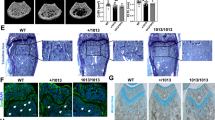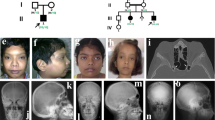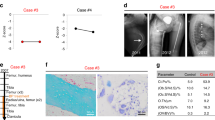Abstract
Autosomal recessive osteopetrosis is usually associated with normal or elevated numbers of nonfunctional osteoclasts. Here we report mutations in the gene encoding RANKL (receptor activator of nuclear factor–KB ligand) in six individuals with autosomal recessive osteopetrosis whose bone biopsy specimens lacked osteoclasts. These individuals did not show any obvious defects in immunological parameters and could not be cured by hematopoietic stem cell transplantation; however, exogenous RANKL induced formation of functional osteoclasts from their monocytes, suggesting that they could, theoretically, benefit from exogenous RANKL administration.
This is a preview of subscription content, access via your institution
Access options
Subscribe to this journal
Receive 12 print issues and online access
$209.00 per year
only $17.42 per issue
Buy this article
- Purchase on Springer Link
- Instant access to full article PDF
Prices may be subject to local taxes which are calculated during checkout


Similar content being viewed by others
References
Frattini, A. et al. Nat. Genet. 25, 343–346 (2000).
Kornak, U. et al. Cell 104, 205–215 (2001).
Chalhoub, N. et al. Nat. Med. 9, 399–406 (2003).
Sly, W.S. et al. Proc. Natl. Acad. Sci. USA 80, 2752–2756 (1983).
Frattini, A. et al. J. Bone Miner. Res. 18, 1740–1747 (2003).
Sobacchi, C. et al. Hum. Mol. Genet. 10, 1767–1773 (2001).
Susani, L. et al. Hum. Mutat. 24, 225–235 (2004).
Pangrazio, A. et al. J. Bone Miner. Res. 21, 1098–1105 (2006).
Kong, Y.-Y. et al. Nature 397, 315–323 (1999).
Lam, J. et al. J. Clin. Invest. 108, 971–979 (2001).
Kim, N. et al. Proc. Natl. Acad. Sci. USA 97, 10905–10910 (2000).
Chen, W. et al. Hum. Mol. Genet. 16, 410–423 (2007).
Nataf, S. et al. Am. J. Pathol. 166, 275–286 (2005).
Mizuno, A. et al. J. Bone Miner. Metab. 20, 337–344 (2002).
Kostenuik, P.J. Curr. Opin. Pharmacol. 5, 618–625 (2005).
Acknowledgements
We are grateful to the affected individuals and their families for their cooperation. We thank R. Dulbecco for encouragement. The work reported in this paper has also been funded by the NOBEL (Network Operativo per la Biomedicina di Eccellenza in Lombardia) Program from Fondazione Cariplo (to P.V. and A.V.) and from a career establishment award of the European Calcified Tissue Society to M.H. and from Telethon grants #GGP06119 to A.T. and #GGP07059 to C.S. This work was supported by grants from Eurostells (STELLAR) and FIRB/MIUR (Fondo per Investimenti Ricerca di Base/Ministero dell'Università e della Ricerca) to P.V. (RBIN04CHXT), grants from Progetto Italia-USA “Malattie Rare” Convenzione n. 526D/61 to P.V. and A.T. and grants from Fondazione Cariplo to A.F. We acknowledge the technical assistance of M.E. Caldana (Segrate), J. Greenhorn and K. Mackenzie (Aberdeen).
Author information
Authors and Affiliations
Contributions
C.S., A.F., L.S. and A.P. performed molecular analysis; M.M.G. and A.V. studied the immunological phenotype; M.A., A.C., R.B., A.T., A.d.F., G.M., N.B., P.G., C.M. and G.E. provided clinical data and bone biopsies; F.P.C. and D.I.S. performed osteoclast studies and immunocytochemical analysis; M.J.R. performed the protein structure-function analysis and P.V., A.V., A.F., M.J.R. and M.H.H. designed the experiments and wrote the manuscript.
Corresponding author
Ethics declarations
Competing interests
The authors declare no competing financial interests.
Supplementary information
Supplementary Text and Figures, Tables
Supplementary Methods, Supplementary Tables 1–3 and Supplementary Figures 1–4 (PDF 2234 kb)
Rights and permissions
About this article
Cite this article
Sobacchi, C., Frattini, A., Guerrini, M. et al. Osteoclast-poor human osteopetrosis due to mutations in the gene encoding RANKL. Nat Genet 39, 960–962 (2007). https://doi.org/10.1038/ng2076
Received:
Accepted:
Published:
Issue Date:
DOI: https://doi.org/10.1038/ng2076
This article is cited by
-
Physiology and diseases of tissue-resident macrophages
Nature (2023)
-
Effect of denosumab treatment on bone mineral density and bone turnover markers in osteoporotic patients: real-life experience 2-year follow-up
Archives of Osteoporosis (2022)
-
A novel mutation in TNFRSF11A gene causes pediatric osteopetrosis: case report
BMC Surgery (2021)
-
RANKL as the master regulator of osteoclast differentiation
Journal of Bone and Mineral Metabolism (2021)
-
A Panel-Based Sequencing Analysis of Patients with Paget’s Disease of Bone Suggests Enrichment of Rare Genetic Variation in regulators of NF-κB Signaling and Supports the Importance of the 7q33 Locus
Calcified Tissue International (2021)



